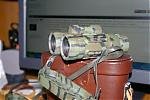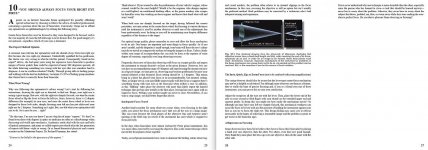Is there an explanation for why a manufacturer would make a binocular focus to infinity in the counter clockwise direction. Most of all my glass that goes back to the 50s focus to infinity in the clockwise direction. At first I thought it was a mistake, but later found it was not.
Andy W.
191212
Hi, Andy:
Some folks bemoan my lack of succinctificatiousnessosicity. But that is because so many don’t give me a question that can be answered succinctly.
First, note that focus is focus is focus. However, getting there—
AND STAYING THERE—is the problem.
Some time ago, it was determined that the best focus could be attained by focusing at infinity and slowly bringing the focus closer to the observer—stopping at the desired image along the way. If I focus my 8x32 Nikon SE at 300 yards, and then on something at the edge of my front yard—30 feet away—I turn the focus wheel counterclockwise. For anyone who understands the WHYS of the procedure, it really shouldn’t matter. Sadly, the story doesn’t end there.
I think the following, from my article on spatial and dioptric accommodations will fill in the gap for you.
DIOPTRIC ACCOMMODATION
The second accommodation of critical importance is
dioptric. Spatial accommodation relates to merging lines of sight along the X and Y axes via the eye’s
rectus muscles.
Dioptric accommodation is achieved through the eye’s ciliary muscles, which stretch and compress the eyelenses in order to achieve a sharp focus.
A 10-year old may have as much as
14 diopters of accommodation. This was the root of Steiner’s bogus claim that their binoculars were
“auto-focus.” But as we age dioptric flexibility drops off fairly quickly. By age 20, it has dropped to 8 to 10 diopters with the average binocular user—40 to 50 years of age—having
only a 4-diopter accommodation. Thus, with each year that passes, the focus mechanism, becomes ever more critical.
Let’s suppose an observer is viewing an image—celestial or terrestrial—and he or she has a dioptric accommodation of 4 diopters. The brain wants to see things in focus quickly. So, involuntarily the
ciliary muscles may bring things to a focus at the edge of the observer’s accommodation. But what if the observer’s
natural/at rest accommodation is -1.5 diopters. Focusing at the edge of accommodation will result in eyestrain and cause the observer to continue adjusting with the focus mechanism in hopes of attaining the sharpest image.
But, without understanding the process, the observer is, more than likely, apt to follow the same procedure that caused the original problem.
Undoubtedly, your mother tried to teach you not to stare. However, if you want the sharpest image, and one that leaves your viewing fiddle free, you had better forget that advice.
Learning to stare comes easily for some people but takes practice for others. Still, learning to stare is worth the effort and is absolutely essential to attaining the sharpest image and most trouble-free focus.










